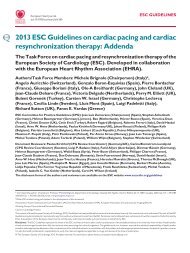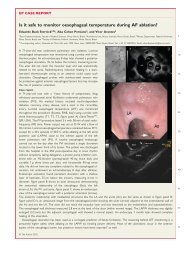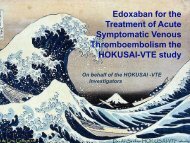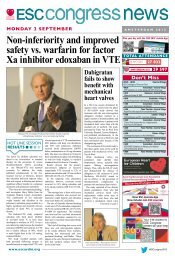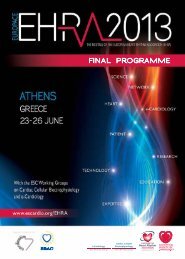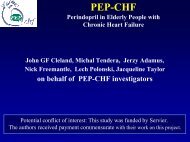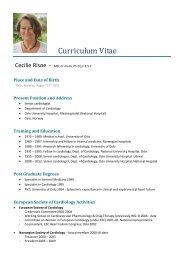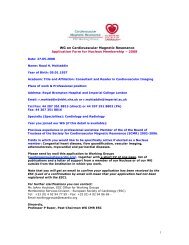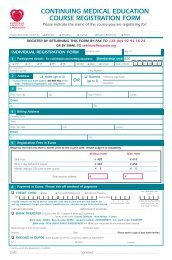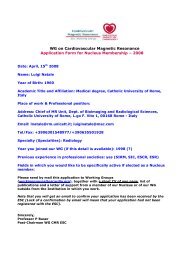EHS on Stable angina - Main publication - European Society of ...
EHS on Stable angina - Main publication - European Society of ...
EHS on Stable angina - Main publication - European Society of ...
Create successful ePaper yourself
Turn your PDF publications into a flip-book with our unique Google optimized e-Paper software.
Page 6 <strong>of</strong> 12 C.A. Daly et al.<br />
Figure 1 Regi<strong>on</strong>al distributi<strong>on</strong> <strong>of</strong> number <strong>of</strong> anti-<strong>angina</strong>l drugs per patient after initial assessment, from the <str<strong>on</strong>g>EHS</str<strong>on</strong>g> <strong>of</strong> <strong>Stable</strong> Angina.<br />
Table 3 Frequency <strong>of</strong> reas<strong>on</strong>s for not prescribing aspirin, beta-blocker or statin treatments in patients from the <str<strong>on</strong>g>EHS</str<strong>on</strong>g> <strong>of</strong> <strong>Stable</strong><br />
Angina<br />
Prior to assessment<br />
n (%)<br />
Post-cardiology assessment<br />
n (%)<br />
a revascularizati<strong>on</strong> strategy were examined using univariate<br />
and multivariable analysis (Table 7 ).<br />
Although patients aged .70 years were less likely<br />
to receive revascularizati<strong>on</strong>, this was not a significant<br />
predictor <strong>of</strong> revascularizati<strong>on</strong> in univariate or multivariable<br />
analysis. Female sex <strong>on</strong> the other hand was a<br />
Reas<strong>on</strong>s for not recommending the drug<br />
n (% <strong>of</strong> those not taking drug)<br />
Taking drug Taking drug Not taking drug C/I Not indicated Await Ix Other/unknown<br />
Aspirin 1803 (48) 2942 (78) 834 (22) 184 (22) 378 (45) 192 (23) 80 (10)<br />
b-Blocker 1404 (37) 2513 (67) 1265 (33) 298 (24) 581 (46) 305 (24) 81 (6)<br />
Statin 825 (22) 1830 (48) 1945 (52) 371 (19) 985 (51) 475 (24) 114 (6)<br />
C/I ¼ specific patient c<strong>on</strong>traindicati<strong>on</strong>.<br />
Await Ix ¼ awaiting further investigati<strong>on</strong> before prescripti<strong>on</strong>.<br />
Table 4 Management status 4 weeks following initial<br />
presentati<strong>on</strong> from the <str<strong>on</strong>g>EHS</str<strong>on</strong>g> <strong>of</strong> <strong>Stable</strong> Angina<br />
Status n (%)<br />
(total ¼ 3779)<br />
Definitive plan in place with<br />
investigati<strong>on</strong>s complete<br />
953 (25)<br />
C<strong>on</strong>servative management 452 (12)<br />
Revascularizati<strong>on</strong> a<br />
501 (13)<br />
Further investigati<strong>on</strong><br />
planned during intervening<br />
period since assessment<br />
674 (18)<br />
Cor<strong>on</strong>ary angiogram 525 (14)<br />
Stress myocardial perfusi<strong>on</strong> scan 97 (3)<br />
Stress echocardiogram 52 (1)<br />
Awaiting clinical review and/or<br />
investigati<strong>on</strong>s planned<br />
at initial assessment<br />
2152 (57)<br />
a<br />
Revascularizati<strong>on</strong> includes procedures already completed within<br />
the 4-week period.<br />
significant independent predictor <strong>of</strong> lower rates <strong>of</strong><br />
revascularizati<strong>on</strong> with an odds ratio <strong>of</strong> 0.58. A positive<br />
exercise test was associated with a greater chance <strong>of</strong><br />
referral for revascularizati<strong>on</strong> (OR 2.49) as were more<br />
severe symptoms (OR 2.58 for CCS III) and use <strong>of</strong> a<br />
greater number <strong>of</strong> anti-<strong>angina</strong>l drugs (OR 1.29). The<br />
availability <strong>of</strong> invasive facilities <strong>on</strong> site and the prevailing<br />
nati<strong>on</strong>al rate <strong>of</strong> cor<strong>on</strong>ary angiography were also significant<br />
and independent predictors <strong>of</strong> revascularizati<strong>on</strong><br />
strategy (OR 1.72 and 2.60, respectively).<br />
Because <strong>of</strong> the substantial variati<strong>on</strong> in the rates <strong>of</strong><br />
referral for cor<strong>on</strong>ary angiography between countries,<br />
separate analysis was carried out for the countries<br />
which had a high (.median) rate <strong>of</strong> referral for cor<strong>on</strong>ary<br />
angiography and those which had a low (,median) rate<br />
<strong>of</strong> referral (Table 8 ). A positive exercise test and sex<br />
were independently predictive <strong>of</strong> the use <strong>of</strong> revascularizati<strong>on</strong><br />
in both circumstances. The availability <strong>of</strong> invasive<br />
facilities <strong>on</strong> site was also a predictive factor in countries<br />
with high nati<strong>on</strong>al rates <strong>of</strong> angiography.<br />
Discussi<strong>on</strong><br />
Sec<strong>on</strong>dary preventi<strong>on</strong><br />
The use <strong>of</strong> evidence-based medical therapy, particularly<br />
sec<strong>on</strong>dary preventi<strong>on</strong> strategies, is far less than ideal in<br />
the survey. Although not so dramatic as MI, <strong>angina</strong> is





